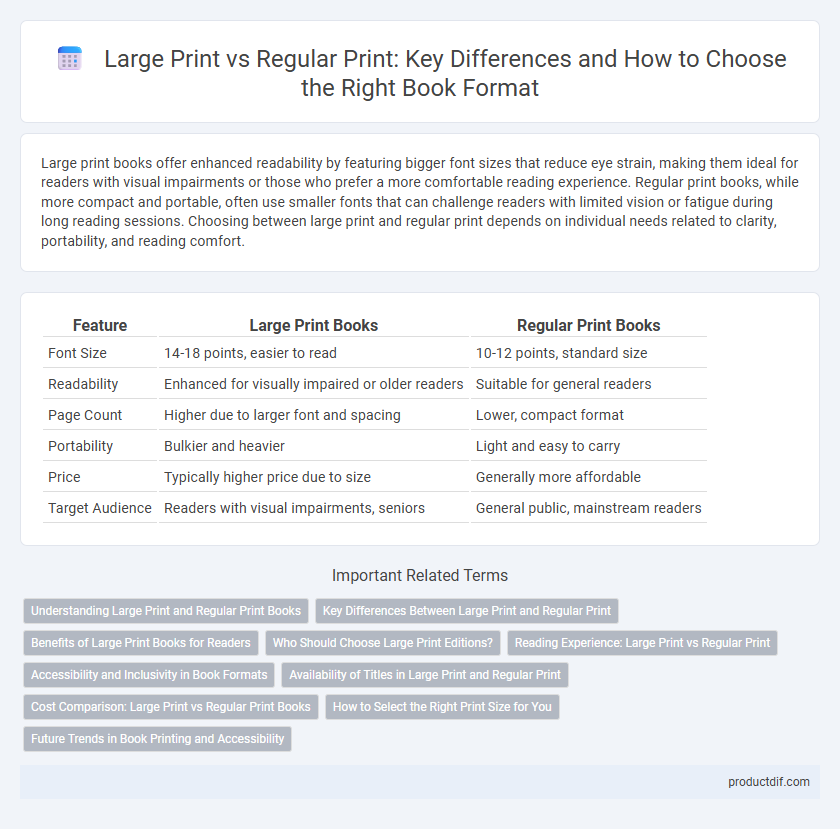Large print books offer enhanced readability by featuring bigger font sizes that reduce eye strain, making them ideal for readers with visual impairments or those who prefer a more comfortable reading experience. Regular print books, while more compact and portable, often use smaller fonts that can challenge readers with limited vision or fatigue during long reading sessions. Choosing between large print and regular print depends on individual needs related to clarity, portability, and reading comfort.
Table of Comparison
| Feature | Large Print Books | Regular Print Books |
|---|---|---|
| Font Size | 14-18 points, easier to read | 10-12 points, standard size |
| Readability | Enhanced for visually impaired or older readers | Suitable for general readers |
| Page Count | Higher due to larger font and spacing | Lower, compact format |
| Portability | Bulkier and heavier | Light and easy to carry |
| Price | Typically higher price due to size | Generally more affordable |
| Target Audience | Readers with visual impairments, seniors | General public, mainstream readers |
Understanding Large Print and Regular Print Books
Large print books feature text typically sized at 16 points or larger, designed to enhance readability for individuals with visual impairments or reading difficulties. Regular print books usually have text sized between 10 to 12 points, optimal for average visual acuity and compact content presentation. Understanding these distinctions aids readers in selecting materials that best suit their reading comfort and accessibility needs.
Key Differences Between Large Print and Regular Print
Large print books feature significantly larger font sizes, typically 16 to 18 points, compared to the 10 to 12 points found in regular print, enhancing readability for visually impaired readers. The layout in large print editions often includes increased line spacing and wider margins, reducing eye strain and improving navigation through the text. Regular print books, while more compact and portable, may pose challenges for readers with low vision due to the smaller, denser typography.
Benefits of Large Print Books for Readers
Large print books offer increased readability by utilizing font sizes typically 16 points or larger, reducing eye strain for individuals with visual impairments such as macular degeneration or presbyopia. These books enhance reading comfort and accessibility, allowing older adults and readers with low vision to enjoy extended reading sessions without fatigue. By improving text clarity and reducing cognitive load, large print editions promote greater reading engagement and retention compared to regular print formats.
Who Should Choose Large Print Editions?
Readers with visual impairments or age-related macular degeneration benefit significantly from large print editions, as the increased font size reduces eye strain and enhances readability. Individuals with dyslexia or other reading difficulties also find large print books easier to navigate, promoting better comprehension and enjoyment. Large print editions are ideal for older adults or anyone who prefers a more comfortable reading experience without the need for magnification tools.
Reading Experience: Large Print vs Regular Print
Large print books feature significantly bigger fonts, typically 16 to 18 points, which reduce eye strain and improve readability for individuals with visual impairments or reading difficulties. Regular print usually ranges from 10 to 12 points, offering a denser text layout that fits more content per page but may cause fatigue during extended reading sessions. Choosing large print enhances comfort and comprehension for slower, more deliberate reading, while regular print suits readers accustomed to faster, continuous reading flows.
Accessibility and Inclusivity in Book Formats
Large print books significantly enhance accessibility for readers with visual impairments by featuring text sizes typically 16 to 18 points, compared to the standard 10 to 12 points in regular print. The availability of large print formats in libraries and bookstores promotes inclusivity by ensuring that individuals with low vision can independently enjoy literature. Publishers investing in diverse book formats, including large print, audiobooks, and e-books with adjustable text sizes, contribute to broader accessibility and equitable reading experiences.
Availability of Titles in Large Print and Regular Print
Large print books offer a more limited range of titles compared to regular print editions, as publishers prioritize mainstream releases for standard formats due to higher demand. Popular genres like bestsellers, classics, and self-help often receive large print versions, though niche or new releases may not be available. Readers seeking extensive selection typically find regular print editions widely accessible in bookstores and online platforms, while large print titles are often found through specialized suppliers or libraries.
Cost Comparison: Large Print vs Regular Print Books
Large print books typically have higher production costs due to the increased paper usage and specialized formatting, making them more expensive than regular print versions. Regular print books benefit from standard printing processes and materials, resulting in lower retail prices. Consumers seeking large print editions should anticipate paying a premium for enhanced readability and accessibility.
How to Select the Right Print Size for You
Selecting the right print size depends on factors like your eyesight, reading comfort, and environment. Large print books typically feature font sizes of 16 points or more, making them ideal for readers with visual impairments or those who prefer less eye strain. Regular print, usually around 10 to 12 points, suits readers with normal vision and offers more content per page, balancing readability and convenience.
Future Trends in Book Printing and Accessibility
Advancements in digital printing technology are driving the future of large print books, making them more affordable and widely accessible to readers with visual impairments. Regular print books are integrating adaptive features like customizable font sizes and high-contrast options through e-readers and print-on-demand services. Increased collaboration between publishers and accessibility organizations is accelerating the development of inclusive book formats that cater to diverse reader needs.
Large Print vs Regular Print Infographic

 productdif.com
productdif.com